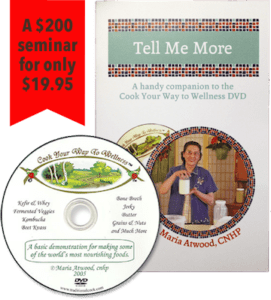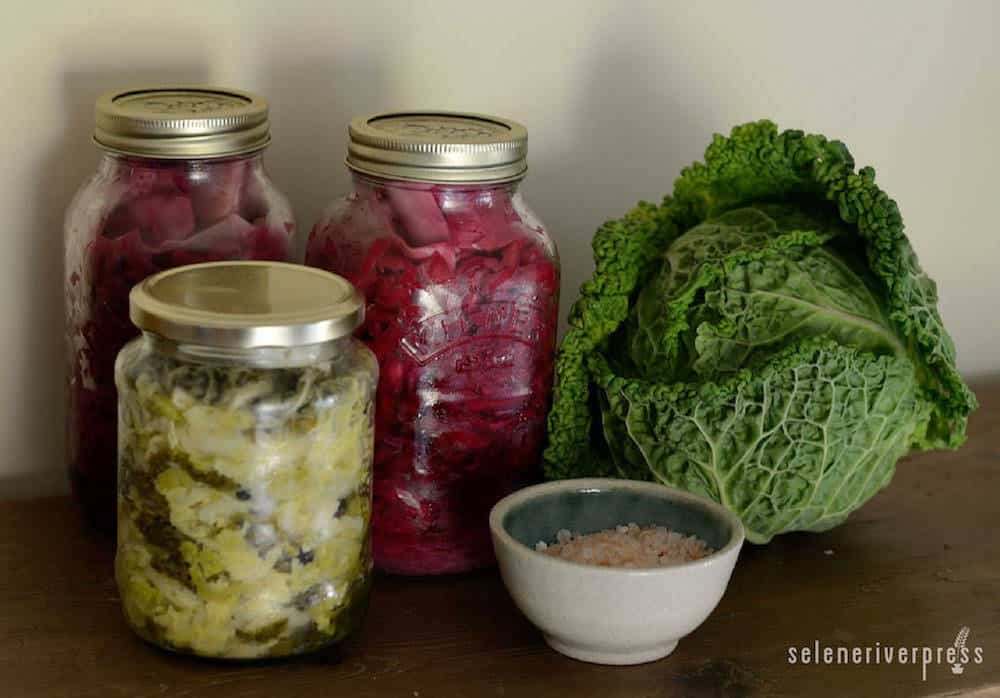Making my own fermented vegetables. I’d been meaning to do it for quite some time, but I was nervous. After all, the lacto-fermentation method in Sally Fallon’s Nourishing Traditions instructs you to leave food in a jar, stored in a regular old cupboard, for several days. How do you keep it safe? Various articles I’d read on the topic said to be cautious about mold growing on the top—and mold is something I never want to bring to the family dinner table.
Despite my concerns, I’d read enough about the health benefits of even a small, daily amount of lacto-fermented foods that I knew I needed to stop avoiding them. While I could simply buy fermented vegetables at a health food store, the good stuff can be quite pricey. And being the curious self-healther I am, I was intrigued by the idea of watching simple, fresh vegetables transform into good, bacteria-laden, fermented vegetables.
Who could help me understand how to ferment veggies with ease?
Nourishing Traditions is filled with all sorts of great information about the history of fermented vegetables, including detailed steps and a variety of recipes to make on your own. But I’m a visual learner, so I kinda wanted someone to just show me how uncomplicated it was. Maria Atwood, CNHP, to the rescue!
Atwood was there for me when I made kombucha for the first time. Could her Cook Your Way to Wellness DVD help me take the next step toward optimal health? After watching her chapter on vegetables, I was a little embarrassed that I hadn’t done it sooner. It seems that if you can chop, measure, stir, and scoop, you can make fermented veggies. I can do all of those things. Time to dive in!
I remembered reading in Nourishing Traditions that using whey in the lacto-fermenting process offers “consistently successful pickling,” but it wasn’t absolutely necessary when fermenting vegetables. A good Celtic salt “inhibits putrefying bacteria for several days until enough lactic acid is produced to preserve the vegetables for many months.” Since I didn’t have any whey, I decided to utilize the salt method for this Spicy Garlic and Dill Pickled Green Beans recipe.
I didn’t have any weights to keep the green beans below the liquid, so I set a reminder on my phone to shake the jars each day (which prohibits any mold from developing at the top). After giving it a daily shake, I watched the liquid in the jar turn cloudy and bubbly. On the fifth day, the true test came: the taste test.
When I opened the jar, my nose was hit with a perfect “pickle” aroma. That was the first sign that everything had gone well. I bit into a green bean. It was still crisp, with a delicious, slightly spicy, garlicky, dill flavor. That was the second sign that everything had gone well. A lovely surprise came with the bubbly sensation it left on my tongue. The effervescent liquid that had been brewing in the pantry closet had steeped directly into that batch of fresh green beans. So cool!!
I did it. I made my own fermented veggies with ease. And I plan to do it again and again and again. As a matter of fact, I have a batch of carrot sticks working their magic in the pantry closet right now.
The sky’s the limit from here on out. Once I prepare some whey, I’ll be making fermented salsa, ginger carrots, and pickled garlic. I’m thrilled to share these tasty morsels with my family.
If you’re interested in gaining this valuable culinary skill, SRP has the learning tools you need. In addition to Fallon’s Nourishing Broth and Atwood’s Cook Your Way to Wellness DVD, you can also check out the following titles:
- Wild Fermentation by Sandor Ellix Katz
- The Art of Fermentation by Sandor Ellix Katz
- With Love from Grandmother’s Kitchen by Monica Corrado
- Making Sauerkraut and Pickled Vegetables at Home by Klaus Kaufmann and Annelies Schoneck
Let the fermenting begin!




What veggies have you tried? Do you put any spices in them for flavor, or is the fermentation enough? I’m new to this but would love to give it a try!
Hi Danielle,
My favorite veggie to use is green beans, maybe it’s because they fit so nicely in the jar. Standing up in there, ready for me to grab hold of one and munch away. :) Carrot sticks are lovely too. As far as the spices, my favorite has been simply using fresh dill springs, a couple of garlic cloves, and red pepper flakes. Make sure you don’t go overboard with the red pepper flakes though – they tend to get spicier and spicier as they sit. Good luck & have fun! Let me know which veggies you try & what your favorite ends up being. Thanks for commenting!